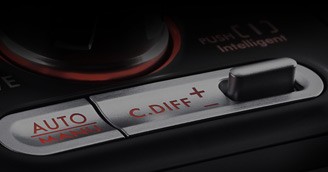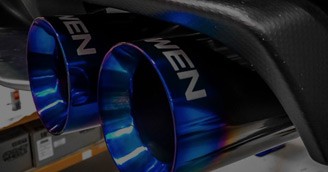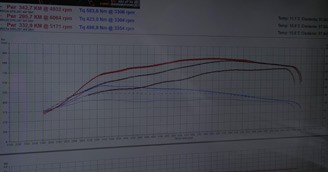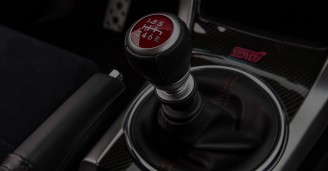Appearance of the body
The bodywork of all 3 compared models is the same and differs only in minor details, if we ignore the different nose at first glance. If you have already bought a car and you are tired of the appearance of the car, there is no problem to rearrange the nose. Fenders are always changed incl. plastic wheel arches, hood with mask, lights, bumper and the upper face of the radiator wall. A skilled bodywork mechanic can handle a facelift in one working day. It's not a problem to convert a 2002 model to a 2006 model or maybe a 2006 to a 2003 model. It's up to you. One of the important functional changes concerns the front headlights. On the 2006-2007 model, xenon lamps are supplied for the first time on the Impreza STI. All 3 cuts have different rear lamps, and due to the fact that the 2002 cut does not have a cutout for the brake shoe, it also has a different rear bumper - straight under the lamp. Unlike the 2003, the Reza 2006 has rear plastic mudguards that extend to the rear bumper. The side skirts are also different, when the 2006 has skirts beautifully curled into a propeller. Every Impreza has it’s own unique feature and is sexy to someone else. One has a combat appearance, the other is more modern. It's up to you what you drive. A possible crash to the face of the car can change your whole idea and setup about the car.
EJ20 vs. EJ25
The most common question asked by everyone who wants to buy a sharp, cool and playful STI. We know from motor head enthusiasts such as subaru owners and mechanics that the EJ20 engine is more reliable. It has a smaller bore, so we have a little "meat" left on the cylinder, whereas the EJ25 block has a larger diameter piston and some material has been removed from that meat in the block. In the cylinder, it heats up more so we often encounter burnt piston rings. On the other hand, the EJ25 engine has half a liter more. Thanks to this, the engine can spin the turbo much earlier and extract much more torque from the engine. When we replace the stock turbo with a two-chamber turbo from the STI Spec C (VF36/VF37) model. And once you feel the new turbo kicking in, the turbo winds up and the delirvey output is unreal. The engine model with a higher capacity no matter the newer model or not it had an upgraded camshaft and intake manifold. Since 2006, the Japanese have put an even bigger oil pump in this engine, identical to the STI Spec C version. It is impossible to say which engine is better or worse. It's up to each of us if we prefer reliability or greater performance and torque. Both of the engines in the Impreza have been running since 2001 to 2006 respectively. And they are often 10-15 years old, so if you have a souped up subby , there is a high probability that we will meet and provide you with forged parts.
Transmission and steering
I assume that you will use the car a lot and abuse it, for example chasing it in Sosnová, Mýta, Béla, on snow, in holes and etc. That's why it's a good idea to choose the 2006 model, which has stronger axles than the older sisters /brothers whatever. The rear ones like to crack very much. Unfortunately, there is a little confusion with the wheel spacing because the Japanese use 5x114.3. The European use 5x100 which is more widespread and in the event of a problem (defect at races, etc) it’s easier to replace. This spacing is also used by older octavias, golfs and etc. If we continue further, the 2006 model also has a more beefer drive shaft. However, I wouldn't take that as an important thing. It seems much more important to me that the steering from the 2006 model is a little thicker than the 2004 steering, so that it can be converted into a sharp steering, which then has only 2 turns. In older controls, this conversion does not work very well. The most fundamental difference in the gearbox is the DCCD central differential, which is missing in previous versions and not so good in newer versions (since 2008), thanks to the installation of a traction control unit by Ing. Pavel Skácel, we can set things up much better and move the flow forward.
Comparison of individual models
Subaru Impreza WRX STI 2001-2002
- Motor EJ20 (1994ccm)
- Turbo IHI VF30
- Power 195kw / 265ps / 343nm
- Mechanical Throttle
- Intake camshaft
- Centre differential
- Thinner Steering Rack (24mm)
- Centre Bore 5x100
- Top Speed 238km/h
Subaru Impreza WRX STI 2003-2005
- Motor EJ20
- Turbo IHI VF34
- Power 195kw / 265ps / 343nm
- Mechanical Throttle
- Intake camshaft
- Same parameters as prevouis years
- Top Speed 244km/h
Subaru Impreza WRX STI *Year Breakthrough 2005
- Motor EJ20
- Turbo IHI VF35
- Power 195kw / 265ps / 343nm
- Intake camshaft
- Mechanical Throttle
- DCCD Differential
- Thicker Steering Rack compare to older models (26mm)
- Stronger and Thicker Drive shaft
- Stronger and Thicker Rear Axle and Bigger Joints
- Pump in the Gearbox
- Centre Bore 5x114.3
- Top Speed 244km/h
Subaru Impreza WRX STI 2006-2007
- Motor EJ25
- Turbo IHI VF43
- Power 206kw / 280ps / 392nm
- Intake Manifold and Exhaust camshaft
- Electric Throttle
- DCCD Differential
- Thicker Steering Rack compare to older models (26mm)
- Stronger and Thicker Drive shaft
- Stronger and Thicker Rear Axle and Bigger Joints
- Pump in the Gearbox
- Centre Bore 5x114.3
- Rear differential Oil Sensor
- Modern Dashboard
- Rear Wing
- Rear Plastic Arches
- Top Speed 255km/h
A Subaru Impreza Without Compromise
2002 IMPREZA S202 STI – Manufactured in a limited edition only 400 pieces
2003 IMPREZA WRX STi Type RA Spec C
2004 IMPREZA S203 - Manufactured in a limited edition 555 pieces
2005 IMPREZA S204 - Manufactured in a limited edition 600 pieces
2006 IMPREZA WRX STI spec C Type RA-R - Manufactured in a limited edition 300 pieces
With this article, I don't want to tell anyone what is and isn't better, I want you to make up your own mind and choose the possible advantages and disadvantages. And as of this result, this will make you come to the conclusion which model and year will suit you the best.






